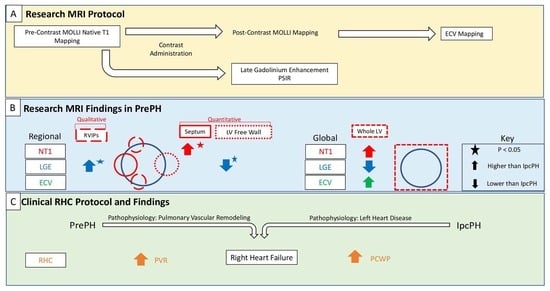Left Ventricular Fibrosis Assessment by Native T1, ECV, and LGE in Pulmonary Hypertension Patients
Abstract
1. Introduction
2. Materials and Methods
2.1. Subjects
Classification
2.2. Cardiac MRI Data Acquisition
2.3. Cardiac MRI Analysis
2.3.1. Volumetric Analysis
2.3.2. Late Gadolinium Enhancement
2.3.3. T1 Mapping
2.4. Statistical Analysis
3. Results
3.1. Subject Characteristics
3.2. Cardiac MRI Findings: Fibrosis Parameters vs. Volumetric Parameters
3.3. Cardiac MRI Findings: Fibrosis Parameters across Groups
3.3.1. Patients vs. Controls
3.3.2. Pre-Capillary PH vs. Isolated Post-Capillary PH
3.4. Cardiac MRI Findings: Interobserver Reliability
4. Discussion
4.1. PrePH Patients with Higher Septal Native T1
4.2. IpcPH Patients with Lower Insertional Point LGE
4.3. PrePH with Higher LV ECV
4.4. Clinical Relevance
4.5. Limitations
5. Conclusions
Author Contributions
Funding
Institutional Review Board Statement
Informed Consent Statement
Data Availability Statement
Conflicts of Interest
References
- Masci, P.G.; Doulaptsis, C.; Bertella, E.; Del Torto, A.; Symons, R.; Pontone, G.; Barison, A.; Droogné, W.; Andreini, D.; Lorenzoni, V.; et al. Incremental Prognostic Value of Myocardial Fibrosis in Patients with Non–Ischemic Cardiomyopathy without Congestive Heart Failure. Circ. Heart Fail. 2014, 7, 448–456. [Google Scholar] [CrossRef] [PubMed]
- Tandon, A.; Villa, C.R.; Hor, K.N.; Jefferies, J.L.; Gao, Z.; Towbin, J.A.; Wong, B.L.; Mazur, W.; Fleck, R.J.; Sticka, J.J.; et al. Myocardial Fibrosis Burden Predicts Left Ventricular Ejection Fraction and Is Associated with Age and Steroid Treatment Duration in Duchenne Muscular Dystrophy. J. Am. Heart Assoc. 2015, 4, e001338. [Google Scholar] [CrossRef]
- Li, A.; Poon, J.W.; Ching, S.; Chan, K.; Chung, T.; Yue, C.; Ha, S.C.; Chang, H.; Ng, M. Pulmonary pressure-to-longitudinal strain ratio by echocardiography: A rapid surrogate to magnetic resonance for right ventricular failure assessment. Eur. Heart J.-Cardiovasc. Imaging 2021, 22, jeaa356.398. [Google Scholar] [CrossRef]
- Swift, A.J.; Rajaram, S.; Capener, D.; Elliot, C.; Condliffe, R.; Wild, J.M.; Kiely, D.G. LGE Patterns in Pulmonary Hypertension Do Not Impact Overall Mortality. JACC Cardiovasc. Imaging 2014, 7, 1209–1217. [Google Scholar] [CrossRef] [PubMed]
- Bradlow, W.M.; Assomull, R.; Kilner, P.J.; Gibbs, J.S.R.; Sheppard, M.N.; Mohiaddin, R.H. Understanding Late Gadolinium Enhancement in Pulmonary Hypertension. Circ. Cardiovasc. Imaging 2010, 3, 501–503. [Google Scholar] [CrossRef]
- Kim, R.J.; Wu, E.; Rafael, A.; Chen, E.-L.; Parker, M.A.; Simonetti, O.; Klocke, F.J.; Bonow, R.O.; Judd, R.M. The use of contrast-enhanced magnetic resonance imaging to identify reversible myocardial dysfunction. N. Engl. J. Med. 2000, 343, 1445–1453. [Google Scholar] [CrossRef] [PubMed]
- Miller, C.A.; Naish, J.; Bishop, P.; Coutts, G.; Clark, D.; Zhao, S.; Ray, S.G.; Yonan, N.; Williams, S.G.; Flett, A.S.; et al. Comprehensive validation of cardiovascular magnetic resonance techniques for the assessment of myocardial extracellular volume. Circ. Cardiovasc. Imaging 2013, 6, 373–383. [Google Scholar] [CrossRef] [PubMed]
- Sibley, C.T.; Noureldin, R.A.; Gai, N.; Nacif, M.S.; Liu, S.; Turkbey, E.B.; Mudd, J.O.; Van Der Geest, R.J.; Lima, J.A.C.; Halushka, M.K.; et al. T1 Mapping in Cardiomyopathy at Cardiac MR: Comparison with Endomyocardial Biopsy. Radiology 2012, 265, 724–732. [Google Scholar] [CrossRef]
- Hong, Y.J.; Park, H.S.; Park, J.K.; Han, K.; Park, C.H.; Kim, T.K.; Yoo, S.J.; Lee, J.Y.; Kim, P.K.; Hur, J.; et al. Early Detection and Serial Monitoring of Anthracycline-Induced Cardiotoxicity Using T1-mapping Cardiac Magnetic Resonance Imaging: An Animal Study. Sci. Rep. 2017, 7, 2663. [Google Scholar] [CrossRef]
- García-Álvarez, A.; García-Lunar, I.; Pereda, D.; Fernández-Jimenez, R.; Sánchez-González, J.; Mirelis, J.G.; Nuño-Ayala, M.; Sánchez-Quintana, D.; Fernández-Friera, L.; García-Ruiz, J.M.; et al. Association of Myocardial T1-Mapping CMR with Hemodynamics and RV Performance in Pulmonary Hypertension. JACC Cardiovasc. Imaging 2015, 8, 76–82. [Google Scholar] [CrossRef]
- Galiè, N.; Humbert, M.; Vachiery, J.-L.; Gibbs, S.; Lang, I.; Torbicki, A.; Simonneau, G.; Peacock, A.; Noordegraaf, A.V.; Beghetti, M.; et al. 2015 ESC/ERS Guidelines for the diagnosis and treatment of pulmonary hypertension The Joint Task Force for the Diagnosis and Treatment of Pulmonary Hypertension of the European Society of Cardiology (ESC) and the European Respiratory Society (ERS): Endorsed by: Association for European Paediatric and Congenital Cardiology (AEPC), International Society for Heart and Lung Transplantation (ISHLT). Eur. Heart J. 2016, 37, 67–119. [Google Scholar] [PubMed]
- Humbert, M.; Kovacs, G.; Hoeper, M.M.; Badagliacca, R.; Berger, R.M.F.; Brida, M.; Carlsen, J.; Coats, A.J.C.; Escribano-Subias, P.; Ferrari, P. 2022 ESC/ERS Guidelines for the diagnosis and treatment of pulmonary hypertension: Developed by the task force for the diagnosis and treatment of pulmonary hypertension of the European Society of Cardiology (ESC) and the European Respiratory Society (ERS). Endorsed by the International Society for Heart and Lung Transplantation (ISHLT) and the European Reference Network on rare respiratory diseases (ERN-LUNG). Eur. Heart J. 2022, 43, 3618–3731. [Google Scholar] [PubMed]
- Simonneau, G.; Montani, D.; Celermajer, D.; Denton, C.P.; Gatzoulis, M.A.; Krowka, M.; Williams, P.G.; Souza, R. Haemodynamic definitions and updated clinical classification of pulmonary hypertension. Eur. Respir. J. 2019, 53, 1801913. [Google Scholar] [CrossRef] [PubMed]
- Hoeper, M.M.; Humbert, M.; Souza, R.; Idrees, M.; Kawut, S.M.; Sliwa-Hahnle, K.; Jing, Z.-C.; Gibbs, J.S.R. A global view of pulmonary hypertension. Lancet Respir. Med. 2016, 4, 306–322. [Google Scholar] [CrossRef] [PubMed]
- Opitz, C.F.; Hoeper, M.M.; Gibbs, J.S.; Kaemmerer, H.; Pepke-Zaba, J.; Coghlan, J.G.; Scelsi, L.; D’Alto, M.; Olsson, K.M.; Ulrich, S.; et al. Pre-Capillary, Combined, and Post-Capillary Pulmonary Hypertension. J. Am. Coll. Cardiol. 2016, 68, 368–378. [Google Scholar] [CrossRef]
- Barnett, C.F.; Selby, V.N. Overview of WHO Group 2 Pulmonary Hypertension Due to Left Heart Disease. Adv. Pulm. Hypertens. 2015, 14, 70–78. [Google Scholar] [CrossRef]
- Califf, R.M.; Adams, K.F.; McKenna, W.J.; Gheorghiade, M.; Uretsky, B.F.; McNulty, S.E.; Darius, H.; Schulman, K.; Zannad, F.; Handberg-Thurmond, E.; et al. A randomized controlled trial of epoprostenol therapy for severe congestive heart failure: The Flolan International Randomized Survival Trial (FIRST). Am. Heart J. 1997, 134, 44–54. [Google Scholar] [CrossRef]
- Koller, B.; Steringer-Mascherbauer, R.; Ebner, C.; Weber, T.; Ammer, M.; Eichinger, J.; Pretsch, I.; Herold, M.; Schwaiger, J.; Ulmer, H.; et al. Pilot Study of Endothelin Receptor Blockade in Heart Failure with Diastolic Dysfunction and Pulmonary Hypertension (BADDHY-Trial). Heart Lung Circ. 2017, 26, 433–441. [Google Scholar] [CrossRef]
- Vachiéry, J.-L.; Delcroix, M.; Al-Hiti, H.; Efficace, M.; Hutyra, M.; Lack, G.; Papadakis, K.; Rubin, L.J. Macitentan in pulmonary hypertension due to left ventricular dysfunction. Eur. Respir. J. 2018, 51, 1701886. [Google Scholar] [CrossRef]
- Naeije, R.; Chin, K. Differentiating Precapillary From Postcapillary Pulmonary Hypertension. Circulation 2019, 140, 712–714. [Google Scholar] [CrossRef]
- Hoeper, M.M.; Lee, S.H.; Voswinckel, R.; Palazzini, M.; Jais, X.; Marinelli, A.; Barst, R.J.; Ghofrani, H.A.; Jing, Z.-C.; Opitz, C.; et al. Complications of Right Heart Catheterization Procedures in Patients with Pulmonary Hypertension in Experienced Centers. J. Am. Coll. Cardiol. 2006, 48, 2546–2552. [Google Scholar] [CrossRef] [PubMed]
- Kraus, P.A.; Lipman, J.; Becker, P.J. Acute Preload Effects of Furosemide. Chest 1990, 98, 124–128. [Google Scholar] [CrossRef] [PubMed]
- Aryal, S.R.; Sharifov, O.F.; Lloyd, S.G. Emerging role of cardiovascular magnetic resonance imaging in the management of pulmonary hypertension. Eur. Respir. Rev. 2020, 29, 190138. [Google Scholar] [CrossRef] [PubMed]
- Kim, R.J.; Shah, D.J.; Judd, R.M. How We Perform Delayed Enhancement Imaging. J. Cardiovasc. Magn. Reson. 2003, 5, 505–514. [Google Scholar] [CrossRef]
- Rahsepar, A.A.; Ghasemiesfe, A.; Suwa, K.; Dolan, R.S.; Shehata, M.L.; Korell, M.J.; Naresh, N.K.; Markl, M.; Collins, J.D.; Carr, J.C. Comprehensive evaluation of macroscopic and microscopic myocardial fibrosis by cardiac MR: Intra-individual comparison of gadobutrol versus gadoterate meglumine. Eur. Radiol. 2019, 29, 4357–4367. [Google Scholar] [CrossRef]
- Gulati, A.; Japp, A.G.; Raza, S.; Halliday, B.P.; Jones, D.A.; Newsome, S.; Ismail, N.A.; Morarji, K.; Khwaja, J.; Spath, N.; et al. Absence of Myocardial Fibrosis Predicts Favorable Long-Term Survival in New-Onset Heart Failure. Circ. Cardiovasc. Imaging 2018, 11, e007722. [Google Scholar] [CrossRef]
- Florian, A.; Ludwig, A.; Rösch, S.; Yildiz, H.; Sechtem, U.; Yilmaz, A. Myocardial fibrosis imaging based on T1-mapping and extracellular volume fraction (ECV) measurement in muscular dystrophy patients: Diagnostic value compared with conventional late gadolinium enhancement (LGE) imaging. Eur. Heart J.-Cardiovasc. Imaging 2014, 15, 1004–1012. [Google Scholar] [CrossRef]
- Mukaka, M.M. Statistics corner: A guide to appropriate use of correlation coefficient in medical research. Malawi Med. J. J. Med. Assoc. Malawi 2012, 24, 69–71. [Google Scholar]
- Condon, D.F.; Nickel, N.P.; Anderson, R.; Mirza, S.; de Jesus Perez, V.A. The 6th World Symposium on Pulmonary Hypertension: What’s old is new. F1000Research 2019, 8, F1000 Faculty Rev-888. [Google Scholar] [CrossRef]
- McHugh, M.L. Interrater reliability: The kappa statistic. Biochem. Med. 2012, 22, 276–282. [Google Scholar] [CrossRef]
- Freed, B.H.; Gomberg-Maitland, M.; Chandra, S.; Mor-Avi, V.; Rich, S.; Archer, S.L.; Jamison, E.B., Jr.; Lang, R.M.; Patel, A.R. Late gadolinium enhancement cardiovascular magnetic resonance predicts clinical worsening in patients with pulmonary hypertension. J. Cardiovasc. Magn. Reson. 2012, 14, 11. [Google Scholar] [CrossRef] [PubMed]
- Patel, R.; Li, E.; Benefield, B.C.; Swat, S.A.; Polsinelli, V.B.; Carr, J.C.; Shah, S.; Markl, M.; Collins, J.D.; Freed, B.H. Diffuse right ventricular fibrosis in heart failure with preserved ejection fraction and pulmonary hypertension. ESC Heart Fail. 2020, 7, 254–264. [Google Scholar] [CrossRef] [PubMed]
- Roller, F.C.; Wiedenroth, C.; Breithecker, A.; Liebetrau, C.; Mayer, E.; Schneider, C.; Rolf, A.; Hamm, C.; Krombach, G.A. Native T1 mapping and extracellular volume fraction measurement for assessment of right ventricular insertion point and septal fibrosis in chronic thromboembolic pulmonary hypertension. Eur. Radiol. 2017, 27, 1980–1991. [Google Scholar] [CrossRef] [PubMed]
- Spruijt, O.A.; Vissers, L.; Bogaard, H.-J.; Hofman, M.B.M.; Vonk-Noordegraaf, A.; Marcus, J.T. Increased native T1-values at the interventricular insertion regions in precapillary pulmonary hypertension. Int. J. Cardiovasc. Imaging 2016, 32, 451–459. [Google Scholar] [CrossRef]
- Saunders, L.C.; Johns, C.S.; Stewart, N.J.; Oram, C.J.E.; Capener, D.A.; Puntmann, V.O.; Elliot, C.A.; Condliffe, R.C.; Kiely, D.G.; Graves, M.J.; et al. Diagnostic and prognostic significance of cardiovascular magnetic resonance native myocardial T1 mapping in patients with pulmonary hypertension. J. Cardiovasc. Magn. Reson. 2018, 20, 78. [Google Scholar] [CrossRef]
- Reiter, U.; Reiter, G.; Kovacs, G.; Adelsmayr, G.; Greiser, A.; Olschewski, H.; Fuchsjäger, M. Native myocardial T1 mapping in pulmonary hypertension: Correlations with cardiac function and hemodynamics. Eur. Radiol. 2017, 27, 157–166. [Google Scholar] [CrossRef]
- Chen, Y.; Yun, H.; Jin, H.; Kong, D.H.; Long, Y.L.; Fu, C.X.; Yang, S.; Zeng, M.S. Association of native T1 times with biventricular function and hemodynamics in precapillary pulmonary hypertension. Int. J. Cardiovasc. Imaging 2017, 33, 1179–1189. [Google Scholar] [CrossRef]
- Blyth, K.G.; Groenning, B.A.; Martin, T.N.; Foster, J.E.; Mark, P.B.; Dargie, H.J.; Peacock, A.J. Contrast enhanced-cardiovascular magnetic resonance imaging in patients with pulmonary hypertension. Eur. Heart J. 2005, 26, 1993–1999. [Google Scholar] [CrossRef]
- McCann, G.P.; Gan, C.T.; Beek, A.M.; Niessen, H.W.M.; Noordegraaf, A.V.; van Rossum, A.C. Extent of MRI Delayed Enhancement of Myocardial Mass Is Related to Right Ventricular Dysfunction in Pulmonary Artery Hypertension. Am. J. Roentgenol. 2007, 188, 349–355. [Google Scholar] [CrossRef]
- Sanz, J.; Dellegrottaglie, S.; Kariisa, M.; Sulica, R.; Poon, M.; O’Donnell, T.P.; Mehta, D.; Fuster, V.; Rajagopalan, S. Prevalence and correlates of septal delayed contrast enhancement in patients with pulmonary hypertension. Am. J. Cardiol. 2007, 100, 731–735. [Google Scholar] [CrossRef]
- Sato, T.; Tsujino, I.; Ohira, H.; Oyama-Manabe, N.; Ito, Y.M.; Noguchi, T.; Yamada, A.; Ikeda, D.; Watanabe, T.; Nishimura, M. Paradoxical Interventricular Septal Motion as a Major Determinant of Late Gadolinium Enhancement in Ventricular Insertion Points in Pulmonary Hypertension. PLoS ONE 2013, 8, e66724. [Google Scholar] [CrossRef] [PubMed]
- Treibel, T.; López, B.; Gonzalez, A.; Menacho, K.; Schofield, R.S.; Ravassa, S.; Fontana, M.; White, S.K.; Disalvo, C.; Roberts, N.; et al. Reappraising myocardial fibrosis in severe aortic stenosis: An invasive and non-invasive study in 133 patients. Eur. Heart J. 2018, 39, 699–709. [Google Scholar] [CrossRef] [PubMed]
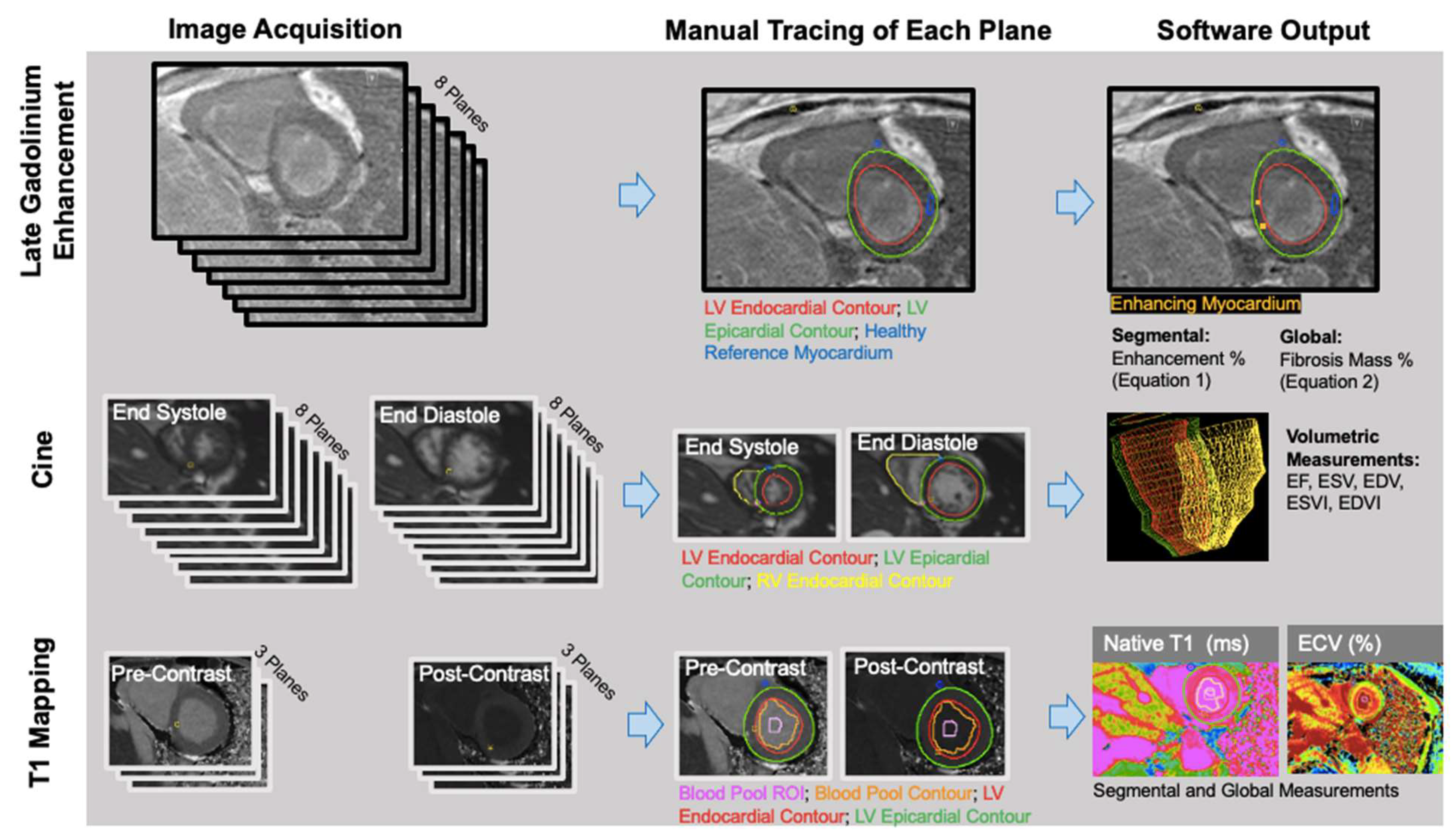
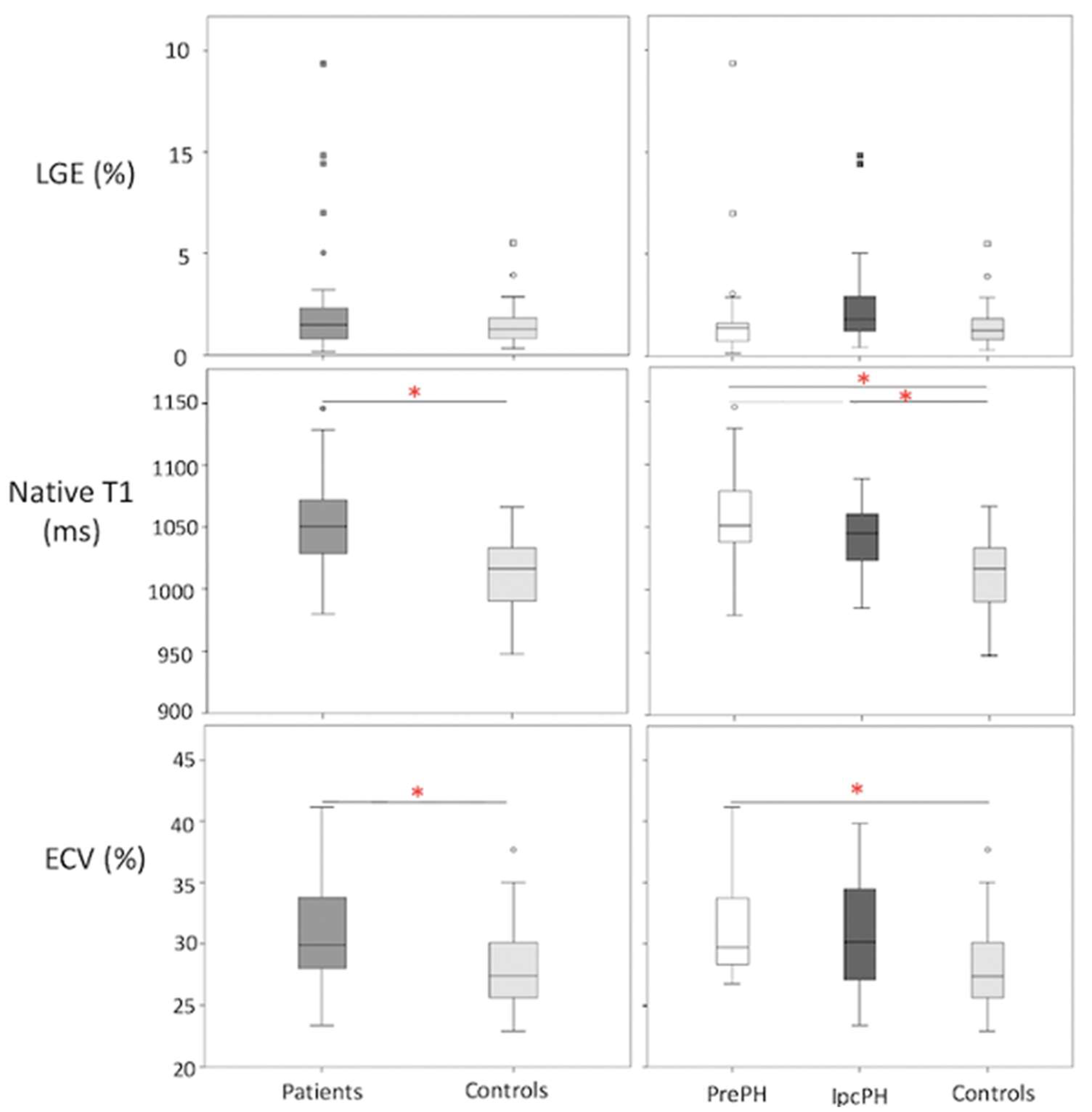
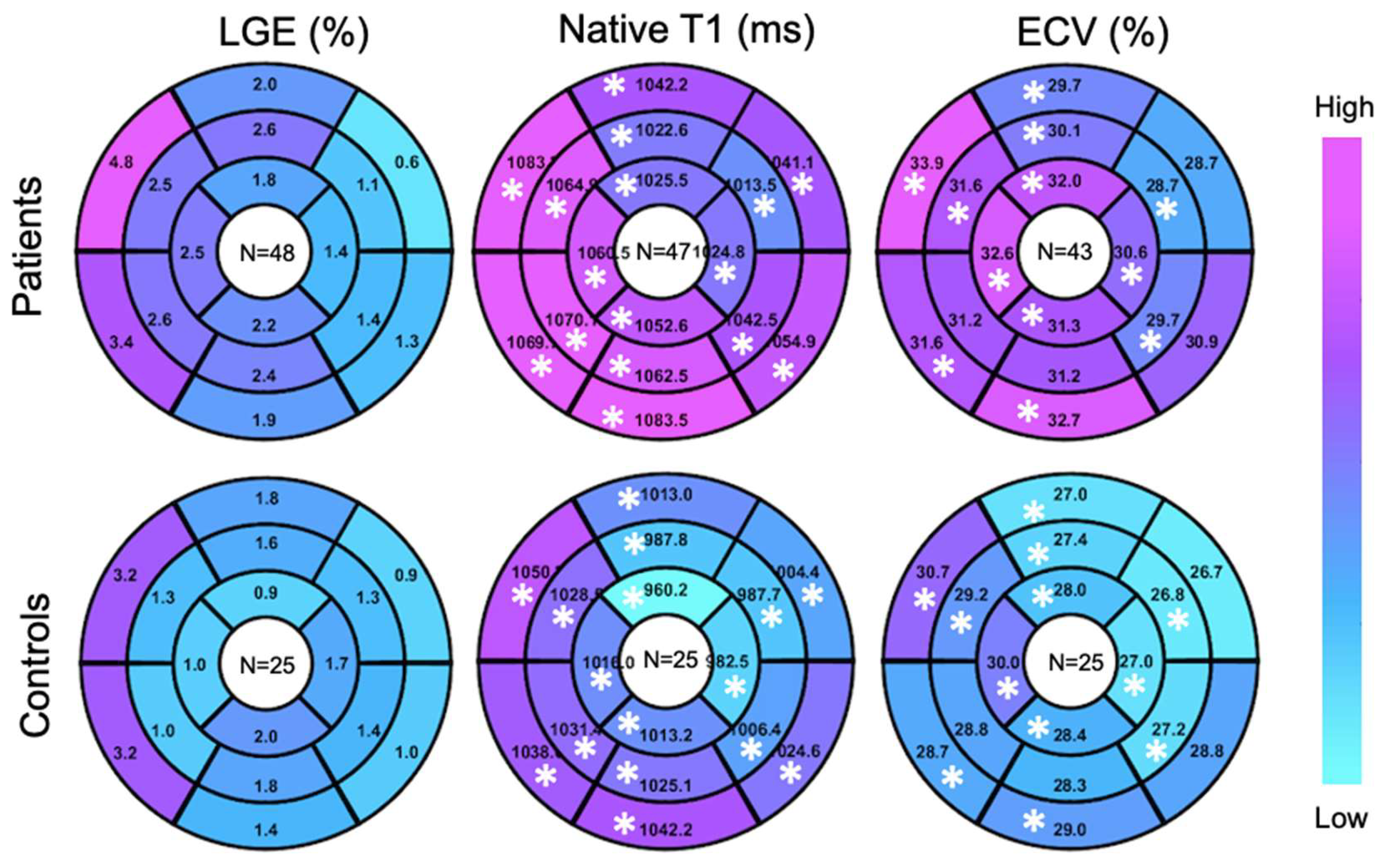
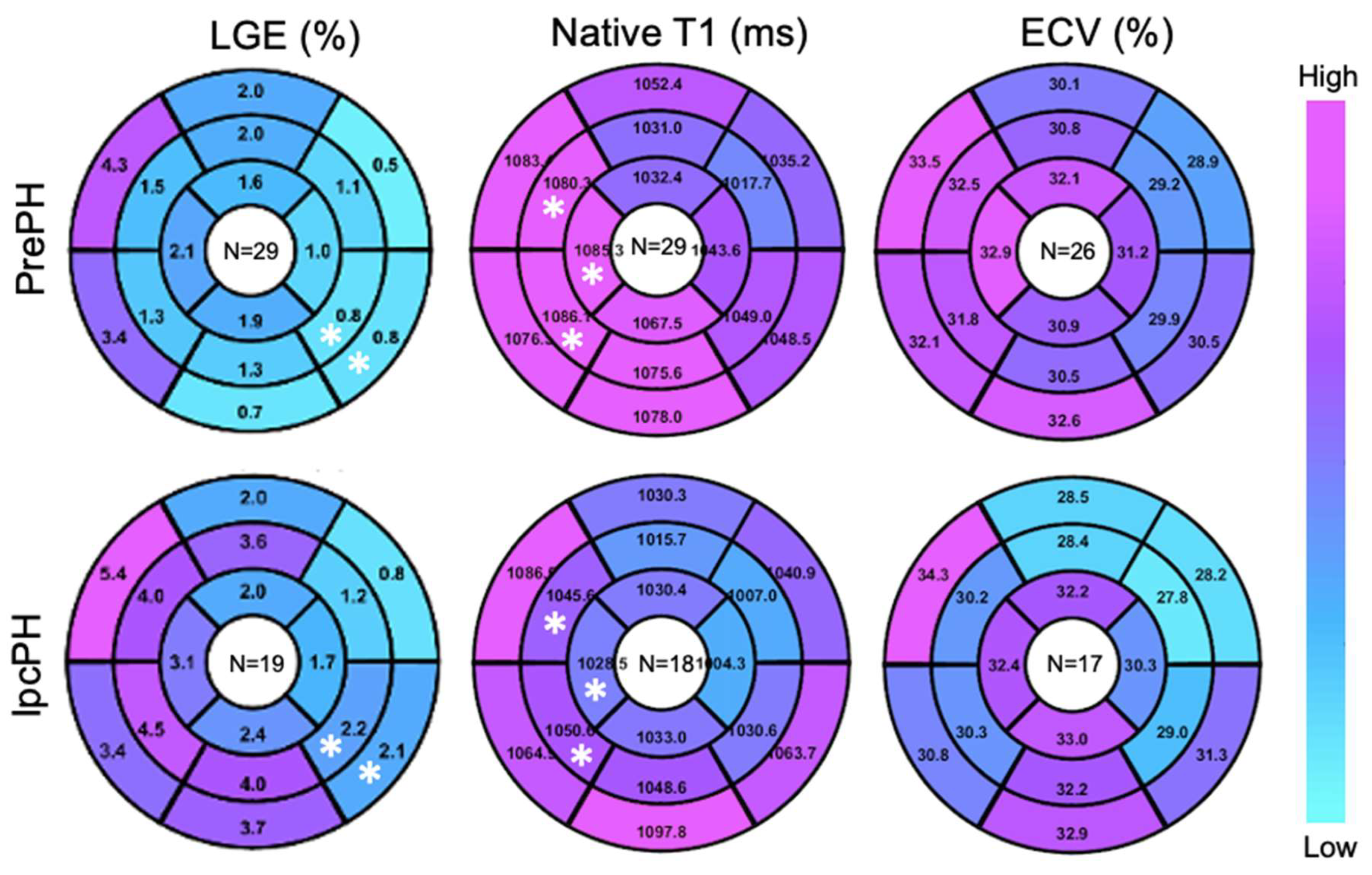
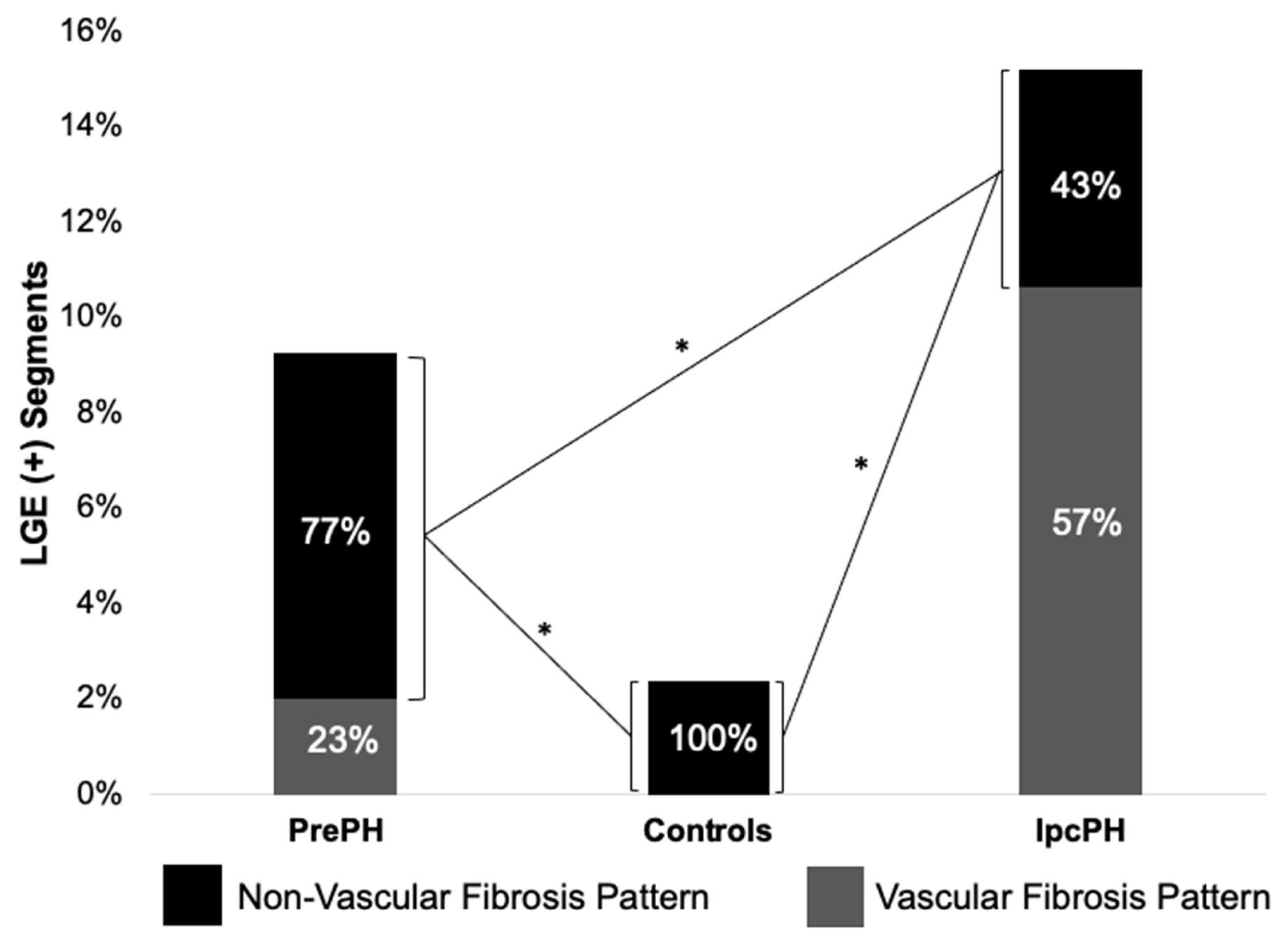
| p-Value | |||||||
|---|---|---|---|---|---|---|---|
| Variables | PrePH (N = 29) | IpcPH (N = 19) | CONT (N = 25) | All | PrePH vs. IpcPH | IpcPH CONT | PrePH vs. CONT |
| Age (years) | 54.8 ± 12.0 | 66.3 ± 12.6 | 52.0 ± 13.2 | <0.05 | <0.05 | <0.05 | 1.000 |
| Males, N (%) | 10 (34.5%) | 9 (47.4%) | 16 (64.0%) | X | 0.555 | 0.634 | 0.059 |
| BMI (kg/m2) | 31.6 ± 7.5 | 32.4 ± 6.6 | 26.2 ± 4.8 | <0.05 | 1.000 | <0.05 | <0.05 |
| Mean PAP (mmHg) | 38.5 ± 11.3 | 32.3 ± 7.3 | X | 0.066 | X | X | X |
| Systolic PAP (mmHg) | 64.4 ± 22.0 | 49.4 ± 9.6 | X | <0.05 | X | X | X |
| Diastolic PAP (mmHg) | 26.0 ± 9.4 | 20.7 ± 4.4 | X | 0.113 | X | X | X |
| Mean RAP (mmHg) | 8.8 ± 3.4 | 11.8 ± 4.8 | X | <0.05 | X | X | X |
| PCWP (mmHg) | 12.8 ± 4.9 | 19.7 ± 4.6 | X | <0.05 | X | X | X |
| PVR (Wood Units) | 6.0 ± 3.5 | 2.847 ± 1.8 | X | <0.05 | X | X | X |
| Variables | p-Value | |||||||
|---|---|---|---|---|---|---|---|---|
| PrePH (N = 29) | IpcPH (N = 18) | CONT (N = 25) | All | PrePH vs. IpcPH | IpcPH vs. CONT | PrePH vs. CONT | ||
| LV | EF (%) | 61 ± 8 | 52 ± 16 | 61 ± 5 | <0.05 | <0.05 | <0.05 | 1.000 |
| EDV (mL) | 130 ± 40 | 162 ± 48 | 141 ± 33 | <0.05 | <0.05 | 0.275 | 0.984 | |
| EDVI (mL/m2) | 64 ± 17 | 81 ± 27 | 73 ± 6 | <0.05 | <0.05 | 0.217 | 0.614 | |
| ESV (mL) | 52 ± 22 | 84 ± 51 | 54 ± 16 | <0.05 | <0.05 | <0.05 | 1.000 | |
| ESVI (mL/m2) | 25 ± 10 | 43 ± 28 | 29 ± 8 | <0.05 | <0.05 | <0.05 | 1.000 | |
| RV | EF (%) | 47 ± 11 | 51 ± 11 | 56 ± 6 | <0.05 | 0.728 | 0.273 | <0.05 |
| EDV (mL) | 171 ± 57 | 151 ± 33 | 152 ± 36 | 0.210 | 0.459 | 1.000 | 0.369 | |
| EDVI (mL/m2) | 83 ± 21 | 76 ± 19 | 79 ± 16 | 0.422 | 0.608 | 1.000 | 1.000 | |
| ESV (mL) | 92 ± 43 | 77 ± 30 | 68 ± 20 | <0.05 | 0.358 | 1.000 | <0.05 | |
| ESVI (mL/m2) | 45 ± 17 | 39 ± 18 | 35 ± 9 | 0.059 | 0.576 | 1.000 | 0.056 | |
| Variables | Global ECV (n = 68) | Global Native T1 (n = 72) | Global LGE (n = 72) | ||||
|---|---|---|---|---|---|---|---|
| r | p-Value | r | p-Value | r | p-Value | ||
| LV | EDV (mL) | −0.099 | 0.422 | 0.008 | 0.948 | 0.342 | <0.05 |
| ESV (mL) | −0.093 | 0.452 | 0.049 | 0.682 | 0.418 | <0.05 | |
| EF (%) | 0.048 | 0.698 | −0.068 | 0.573 | −0.334 | <0.05 | |
| EDVI (mL/m2) | −0.180 | 0.141 | −0.017 | 0.889 | 0.318 | <0.05 | |
| ESVI (mL/m2) | −0.128 | 0.298 | 0.037 | 0.759 | 0.401 | <0.05 | |
| RV | EDV (mL) | −0.013 | 0.917 | 0.224 | 0.061 | 0.090 | 0.453 |
| ESV (mL) | −0.008 | 0.947 | 0.287 | <0.05 | 0.113 | 0.346 | |
| EF (%) | −0.033 | 0.788 | −0.279 | <0.05 | −0.089 | 0.459 | |
| EDVI (mL/m2) | −0.101 | 0.412 | 0.239 | <0.05 | 0.073 | 0.542 | |
| ESVI (mL/m2) | −0.055 | 0.657 | 0.315 | <0.05 | 0.116 | 0.330 | |
Disclaimer/Publisher’s Note: The statements, opinions and data contained in all publications are solely those of the individual author(s) and contributor(s) and not of MDPI and/or the editor(s). MDPI and/or the editor(s) disclaim responsibility for any injury to people or property resulting from any ideas, methods, instructions or products referred to in the content. |
© 2022 by the authors. Licensee MDPI, Basel, Switzerland. This article is an open access article distributed under the terms and conditions of the Creative Commons Attribution (CC BY) license (https://creativecommons.org/licenses/by/4.0/).
Share and Cite
Cerne, J.W.; Pathrose, A.; Sarnari, R.; Veer, M.; Chow, K.; Subedi, K.; Allen, B.D.; Avery, R.J.; Markl, M.; Carr, J.C. Left Ventricular Fibrosis Assessment by Native T1, ECV, and LGE in Pulmonary Hypertension Patients. Diagnostics 2023, 13, 71. https://doi.org/10.3390/diagnostics13010071
Cerne JW, Pathrose A, Sarnari R, Veer M, Chow K, Subedi K, Allen BD, Avery RJ, Markl M, Carr JC. Left Ventricular Fibrosis Assessment by Native T1, ECV, and LGE in Pulmonary Hypertension Patients. Diagnostics. 2023; 13(1):71. https://doi.org/10.3390/diagnostics13010071
Chicago/Turabian StyleCerne, John W., Ashitha Pathrose, Roberto Sarnari, Manik Veer, Kelvin Chow, Kamal Subedi, Bradley D. Allen, Ryan J. Avery, Michael Markl, and James C. Carr. 2023. "Left Ventricular Fibrosis Assessment by Native T1, ECV, and LGE in Pulmonary Hypertension Patients" Diagnostics 13, no. 1: 71. https://doi.org/10.3390/diagnostics13010071
APA StyleCerne, J. W., Pathrose, A., Sarnari, R., Veer, M., Chow, K., Subedi, K., Allen, B. D., Avery, R. J., Markl, M., & Carr, J. C. (2023). Left Ventricular Fibrosis Assessment by Native T1, ECV, and LGE in Pulmonary Hypertension Patients. Diagnostics, 13(1), 71. https://doi.org/10.3390/diagnostics13010071





